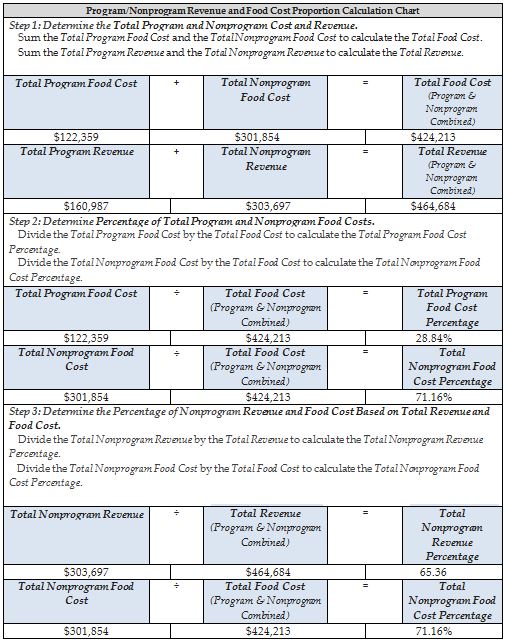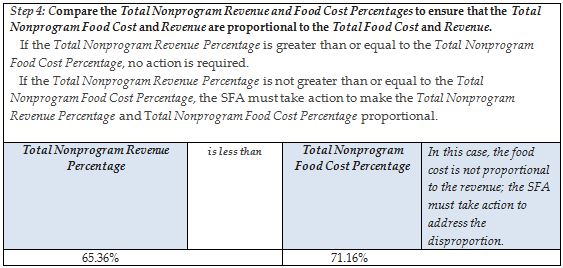Nonprogram Revenue and Food Costs
Proportion of Program/Nonprogram Revenue and Food Cost
Each year, SFAs must assess their revenue from program food (reimbursable meals) and nonprogram food (non-reimbursable meals) to ensure that nonprogram food revenue generates at least the same proportion of revenue as it contributes toward total food costs.
Revenue - For the program/nonprogram proportion, revenue is all money that is provided to the SNP account. This includes, but is not limited to, the following:
- Federal reimbursement
- State or local funds, such as per meal subsidies and State revenue matching funds
- Children’s payments for reimbursable meals and a la carte sales
- Credits, rebates, and discounts and USDA Foods values credits
- Income from catering, adult meals, vended meals
- Payments for items purchased for fund raisers and vending machines
Nonprogram Revenue - For the program/nonprogram proportion, nonprogram sales include, but are not limited to, the following:
- A la carte items sold in competition with reimbursable meals
- Adult meals
- Catered or vended meals
- Items purchased for fundraisers, vending machines, and school stores
Costs - For program/nonprogram proportion, the SFA will use only the cost of the actual food. The SFA will not include labor or other costs in this calculation. [NOTE: If the menu item is made from scratch, the SFA would need to determine the price of all ingredients to calculate the food costs.]
Costs for Each Meal - Calculating program and nonprogram food revenue and costs is essential to knowing the cost of each item served and each meal served.
If the nonprogram food revenue is not proportional to program food revenue, the SFA must take action immediately to make the program/nonprogram revenue proportional. Proportional means that the food costs for nonprogram foods must be equal to or greater than program food costs, and nonprogram revenue must be equal to or greater than program revenue.
Steps for Calculating Proportion of Program/Nonprogram Revenue
The SFA should calculate the proportion of total nonprogram food costs by taking the following actions:
Step 1: Determine the total program and nonprogram cost and revenue.
Step 2: Determine the percentage of total program and nonprogram food cost.
Step 3: Determine the percentage of nonprogram revenue and food cost based on total revenue and food cost.
Step 4: Compare the total nonprogram revenue and food cost percentages to ensure that the total nonprogram food cost and revenue are proportional to the total food cost and revenue.
The Program/Nonprogram Revenue/Food Revenue and Cost Calculation Chart illustrates an example of the calculation to determine the correct proportion of program/nonprogram revenue/food cost.


SFAs may use the Program/Nonprogram Revenue Proportion Calculation Worksheet to calculate the proportion of program and nonprogram income and expenses.
Adjusting the Proportion for Program/Nonprogram Revenue/Costs
The SFA may adjust the nonprogram revenue in a variety of ways including, but not limited to, increased prices for nonprogram food items and contribution of funds from non-Child Nutrition sources. The SFA must use the following guidance in establishing proportional program/nonprogram revenue and costs:
Different Nonprogram Foods - A SFA may choose to increase the price of one type of nonprogram food revenue more than another type. This is permissible as long as the proportional requirement is met.
Direct or Indirect Charges - A SFA may choose to increase the price of one type of nonprogram food revenue more than another type. This is permissible as long as the proportional requirement is met.
Special Circumstances - If the SFA’s normal months of operation are impacted by a natural disaster, the SFA may use a representative month to determine revenue or income for the fiscal year. The SFA should contact NYSED if this occurs.
Helpful Links - Nonprogram Foods
Nonprogram Food Revenue Tool and Instructions
Memo SP20-2016 Nonprofit School Food Service Account Nonprogram Food Revenue Requirements USDA FNS
Memo Providing Meals to School Food Service Employees



